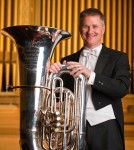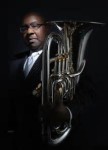A successful teacher, soloist and chamber musician, Jamie Lipton has explored the traditional aspects of euphonium playing with grace and aplomb. A protege of Brian Bowman and Rex Martin, her performances and pedigree have prepared her to address the frontiers that lie ahead for the tribe of “The Fourth Valve” tm. Enjoy!
1. Three friends meet after a band/wind ensemble rehearsal. One friend plays euphonium, another trombone, and a third tuba. None of them double on another instrument. The tubist and the trombonist could both be heading to quintet, and later orchestra. The trombonist may be headed for jazz or pop music. Does this intensify the desire for the euphonium player to become a classical soloist? or put them in a box?
Euphonium players are starting to break down barriers – I play euphonium quite a lot in two different professional brass quintets, for example. Admittedly, it is kind of annoying that euphoniumists rarely get to play in orchestras. Many of my colleagues at Henderson are members of local professional orchestras or get called frequently to sub, and I am somewhat jealous that I don’t have that opportunity on a regular basis.
I am very fortunate that I get to play in a brass band. It doesn’t pay, but it’s so much fun and very musically rewarding for me. The fact that many ensembles don’t use euphonium doesn’t so much make me want to focus on solo literature as it makes me wish I were a better trombonist!
2. How do you conceive of and execute tone color differently as a soloist as compared to an ensemble?
As a soloist, you get to choose the tone color you want to use. In an ensemble, you’re limited to the colors that blend with whatever instrument is playing with you. I’ve noticed that some older euphonium players, when they play in band, play very soloistically no matter who’s playing with them – I think this is because bands and band composers used to appreciate the euphonium more.
There is still a lot of great new wind band music being written, but many modern composers don’t seem to understand what the euphonium is capable of. If I had my way, I’d play with a beautiful, singing tone (and vibrato!) most of the time, but when I’m playing whole notes in octaves with the tubas, that’s not very practical.
3. How many high school or college euphonium players would you estimate come into contact with the music of Rich Matteson or Bob Brookmeyer? Are jazz euphonium/valve players well known?
I’d say they are well-known among three groups of people: euphonium pedagogues, jazz pedagogues, and young euphonium players who are really into jazz (particularly at UNT). I have played in many jazz bands, but more for education than enjoyment. I haven’t spent much time listening to Matteson or Brookmeyer, but I certainly appreciate what they did for the whole concept of jazz euphonium/valve trombone. Anyone who takes the euphonium to places it doesn’t normally go has all of my respect!
 4. What chamber music experiences have you had? What chamber music opportunities would you have like to have had? Do you see any potential niches for euphonium in chamber music?
4. What chamber music experiences have you had? What chamber music opportunities would you have like to have had? Do you see any potential niches for euphonium in chamber music?
As a euphoniumist, I have played in tuba quartets, euphonium quartets, and brass quintets (where I play the trombone part). Tuba quartets have some GREAT rep if you’re willing to look for it. I think the idea of a euphonium quartet is relatively new and exciting, although there’s not a lot of rep. Some of my friends from UNT have a euph quartet that’s been touring and seems to be gaining some attention. It’s such a versatile instrument that the possibilities are endless!
I had a fun experience last summer where I played a bassoon part in a woodwind quintet. I was muted the whole time, but that was my choice cause I thought it sounded more like a bassoon. (I did this once in my high school orchestra, too.) Would that count as a niche? Many small collegiate music departments don’t have a lot of double reeds. Maybe muted euphonium could catch on as a bassoon substitute in woodwind quintets.
5. What do you do for a warm up? How has it changed since college?
I think any college professor will tell you that they no longer have time for the 45-minute warm-up they did as a student. I used to play tons of Remington exercises before I’d even think about practicing. Now, sometimes I only have a few 10-minute breaks between lessons to do all of my practicing for the day. When I’ve been away from my instrument, I like to play tunes by ear. Themes from orchestral rep, musical theatre, folk songs, whatever – and I encourage my students to do the same. Tunes get you re-acclimated to your horn, they get you listening to sound and intonation, and most importantly they get you thinking about making music. Lately I’ve been playing “Make Our Garden Grow†from Bernstein’s Candide in three or four different keys. After that, I’m ready to go.
Rex Martin, my professor at Northwestern, impressed upon me the idea that any musician should be able to play a gig with no warm up, because you never know when you might have to do that. Mark Carlson and I started a routine one summer where we would show up to the practice rooms on Monday morning and play a solo for each other with no warm-up. It was a productive exercise, and I’d recommend it to anyone who feels dependent on their current warm-up routine.
6. Trumpet players typically own 2 to four different sized instruments, from piccolo to C, Bb to Flugel. Many  tubists perform on two tubas, either Bb or C and F. many trombonists now play small and large bore tenor, or tenor and bass. Euphonium players tend to play everything on one size of instrument.
tubists perform on two tubas, either Bb or C and F. many trombonists now play small and large bore tenor, or tenor and bass. Euphonium players tend to play everything on one size of instrument.
How do you account for the apparent lack of timbrel contrast?
I don’t see a lack of contrast. I think the euphonium has a great range of tone colors by itself. Also, a lot of those extra instruments listed above are used specifically for orchestra and jazz, which aren’t really genres that use euphonium. But we do have options – small bore euphs (usually used in jazz), baritones (used in brass band and sometimes in wind ensemble and tuba choir), and marching instruments.
7. How much time (& how) do you practice vibrato? Without ? How does it help you be expressive?
As I said earlier, I love to play with vibrato. It makes the euphonium sound like a singing voice, and I think the voice is the most expressive of all the instruments. Vibrato came very naturally to me as a kid because I listened to so much vocal music – once my teacher told me how to use my lips/jaw to produce vibrato, I was off and running because I knew exactly how I wanted it to sound. I don’t spend much time practicing vibrato anymore, but when my students learn vibrato I have them do pitch-bending exercises with a metronome, and I tell them to have a concept of what/who they want their vibrato to sound like.
The only times I practice without vibrato are 1) when I’m playing technical exercises like long tones or lip slurs, 2) when I’m practicing a passage where I’ve specifically decided not to use vibrato, and 3) when I’m practicing trombone (and even then I use a little bit).
8. What is the best euphonium playing you have ever heard?
My favorite player is Brian Bowman – he was the first professional euphoniumist I ever heard, and I studied with him for both of my advanced degrees. I think my favorite time I ever heard him play was when he performed the second movement of the John Stevens concerto (a lovely piece of music). I was turning pages for the pianist at this particular performance, and I was just so moved by Dr. Bowman’s tone and musicality that I could barely perform my one task.
Honorable mentions for best euphonium playing I’ve ever heard would have to include Demondrae Thurman playing Mahler’s “Songs of a Wayfarer†– so beautiful! – and for technical prowess, Ben Pierce. I don’t remember what he played at ITEC but I do remember being deeply impressed and a little disgusted; that man’s technique is insane.
9. What is the best euphonium playing you have ever done?
Never being satisfied with my own playing, this question is difficult to answer. I’ve played in many rounds of many different auditions and competitions, not to mention solo recitals – but nothing really stands out as the best I’ve ever done because I always remember what could have gone better. I will say that I was pretty happy with my last recital. While there were some things I could have improved, I think the audience really enjoyed my musicianship and my programming. I had a GREAT accompanist-and I enjoyed myself.
10. What are your musical and non musical influences?
Vocal music, specifically musical theater. I love to sing, and when I was a kid I wanted to be a singer on Broadway. I think listening to so much high-quality singing when I was young was the main thing that shaped me as a musician. My first music lessons were in piano, and I was a Suzuki student, which meant that I learned all of my music by ear. When I eventually learned to read music, my teacher began DRILLING me on scales and music theory. I didn’t enjoy it very much at the time, but when I got to high school I realized that reading music and understanding it came so much more easily to me than to most of my peers.
Lately, my biggest non-musical influence has been sports, specifically soccer. I am a huge fan of soccer and watching world-class athletes play has made me realize, as many people have done, the similarities between athletics and music performance. Using sports-oriented visualization exercises (for example, imagining taking a penalty kick) has helped me with my practice strategies, my accuracy, and my performance anxiety. I haven’t read “The Inner Game of Tennis†but I should, because I would probably find a lot more ideas that would influence my playing in a positive way.
c. 2015 David William Brubeck All Rights Reserved. davidbrubeck.com
Interested in more “The Fourth Valve” tm Interviews?
 Don Harry
Don Harry
John Stevens
Jim Self
John Van Houten
Demondrae Thurman
Deanna Swoboda
R. Winston Morris
 Beth Wiese
Beth Wiese
Aaron Tindall
Marty Erickson
Beth Mitchell
Chitate Kagawa
Aaron McCalla

